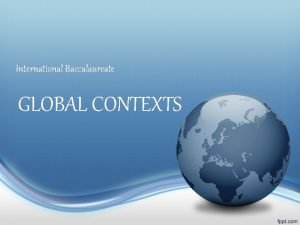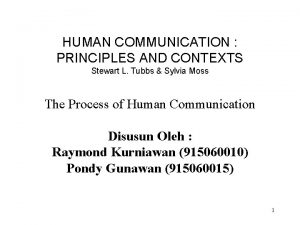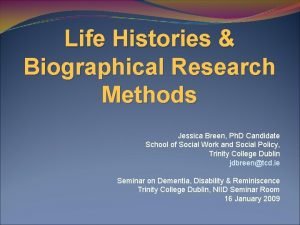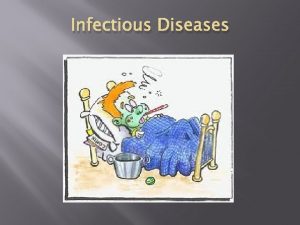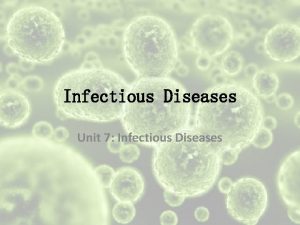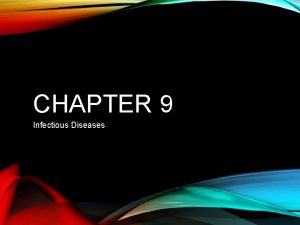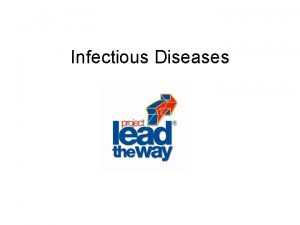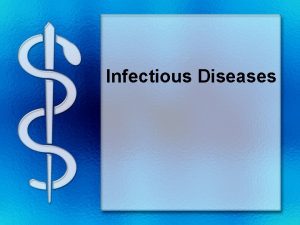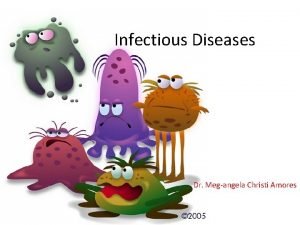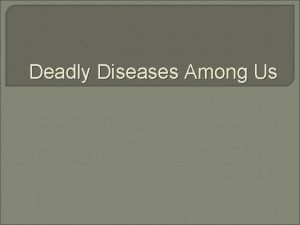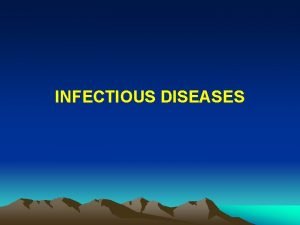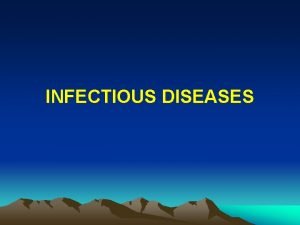Infectious Diseases This chapter considers the contexts histories



















- Slides: 19

Infectious Diseases This chapter considers the contexts, histories, and causes of infectious diseases as well as the ways in which diseases are caused and affected by social relations between people and societies.

Microbes and Infectious Diseases • Microbes: microscopic organisms, including viruses, bacteria, parasites and fungi, that inhabit every imaginable niche in every ecosystem on the planet, including human communities and human bodies. • Most of the time we live in relative equilibrium with microbes • Some well-adapted microbes learn to live off their hosts, while maladapted microbes or ones the host has not yet developed an immunity to, kill their hosts.

Microbes and Infectious Diseases • Humans are dependent upon microbes like bacteria in our intestines to help us digest food – a symbiotic relationship. • Sometimes microbes threaten humans, functioning as pathogens – disease causing agents that enter the host and begin to reproduce, weakening or killing the host in the process • Most ‘successful’ microbes do not kill hosts • Widespread death when microbes infects a population that has no previous exposure • Microbe kills all but most resistant, susceptible hosts die; survivors develop enduring immunity. Deadliest strains die off and balance/tolerance returns

Humans and Disease • Human DNA indicates that we have a long history of immunizing ourselves against diseases – sickle cell red blood cells may protect against malaria parasite • Foragers were isolated so although disease existed in enclaves populations were too sparse and mobile to support acute diseases – smallpox, measles, chicken pox that produce long-lasting immunities. • These would have burnt out – either killing or immunizing hosts • Domestication changed human interaction with the environment in ways that introduced them to new pathogens. Food storage, for example, exposed them to the pathogens carried by rodents.

Humans and Disease • Crowd diseases develop in overcrowding and poor sanitation and may have jumped from domesticated animals: smallpox (cows), measles (sheep, cattle, goats), influenza (poultry), tuberculosis (cattle) • Urban areas proved to be major breeding grounds for pathogens. • Global trade introduced new groups to pathogens for which they had no immunity. • Started with the Silk Road and other trade routes – e. g. Black Death in 14 th Century • Urban living & public places made epidemics (persistent in a particular geographic area) and pandemics (many people in many different locations) possible.

Epidemics and Pandemics • Mongol hordes and long distance trade between China and Europe were likely causes of frequent plague outbreaks 1300 -1660 s, including ‘Black Death” • ‘Black Death’ had mortality of 30 – 50% in Europe and Middle East • Colonialism spread diseases such as smallpox, syphilis, tuberculosis, devastating indigenous peoples from Africa to the south Pacific. • In particular colonization of the Americas brought huge number of deaths to indigenous peoples

Epidemics and Pandemics • Exploration of Africa and Asia introduced Europeans to mosquito borne diseases such as malaria, dengue and yellow and parasitic diseases caused by worms – so much that it was called the ‘white man’s grave. ’ • Cholera epidemic that emerged in India in early 1800 s quickly spread to Britain and prompted first major efforts at public health and provision of sanitation systems and cleaner drinking water. • The industrial revolution helped spread disease via improved transportation routes and competition for expanded markets and raw materials. • Quicker transportation meant pathogens could survive long enough to reach new populations.

Epidemics and Pandemics • In many wars more troops died of disease especially typhus than died from battle – Napoleonic Wars, Crimea, South African War. • War also led to increased epidemics as food routes and supplies were disrupted and people were forced to live in unsanitary conditions. • Spanish flu pandemic post-WW 1 killed as many as 50 million worldwide • Even now we have regular outbreaks of Asian flu, Bird flu, Swine flu, etc.

Combating Disease • Historically, quarantines, quick disposal of dead, and religious rites were used to try to deal with diseases. • Improved conditions for soldiers and advances in medical science helped to combat diseases. – Better food rations, clean clothing, fumigation for lice and fleas, and, most importantly, provision of clean water supplies and other sanitary measures helped reduce morbidity and mortality rates among soldiers. • Vaccination against smallpox using cowpox pioneered by Edward Jenner in 1798. • Later, vaccinations were used to immunize populations against a disease causing agent.

Combating Disease, con’t. • In 1849, Snow showed how a cholera epidemic could be stemmed simply by cutting off access to infected water supply but even today millions still suffer from cholera and diarrheal diseases because they do not have access to clean water. • Not until the late 1800 s did the germ theory of contagion become widely accepted. • In some cases politics gets in the way of curing diseases where there is a relatively easy cure as seen in apartheid South Africa.

Combating Disease, con’t. • At turn of 20 th century medical establishment realised coordinated global efforts were required to combat disease • The International Office of Public Hygiene, established in Paris in 1909, led the way to formation of other international organisations • The United Nations’ World Health Organization (WHO) • Centers for Disease Control in the U. S. (CDC) • Medical NGOs such as Doctors Without Borders

Combating Disease, con’t. • New drugs and chemicals were developed in the twentieth century to attack pathogens in the environment and in the body, such as DDT and antibiotics. • Some pathogens are now developing resistance to antibiotics, in part because of their widespread use/overuse. • Examples: MRSA, MERS Corona virus.

Leading Causes of Death & Illness Currently, diseases that account for the most deaths worldwide include: • Acute lower respiratory tract infections • HIV/AIDS: claims approximately three million lives a year • Diarrheal diseases • Tuberculosis: Every year, about 8. 8 million people develop TB and 1. 7 million die of it • Malaria: takes approximately 3000 lives a day

The Flu • Various flus are an ever present threat, from swine to avian flu. • Every year in the United States, on average: – 5 percent to 20 percent of the population gets the flu. – More than 200, 000 people are hospitalized from flu related complications. – About 36, 000 people die from the flu

Disease, the Environment, and Food Production • Climate change • “Human made” malaria • Expansion into natural environments, e. g. Lyme disease • Disease corridors • ‘Mad cow disease’ and factory farming • E Coli from manure and the widespread use of antibiotics on factory farms increases microbial resistance to drugs

Global Connections – Urbanization, Air Travel and Migration • By 2030 c. 5 billion out of 8. 1 billion people will live in cities and these will grow twice the rate of population expansion. Most growth will be in developing regions of Africa and Asia • Forecasters predict there will be 12 megacities in Asia alone and all but four megacities will be in developing world • Metacities will also develop – Tokyo is the largest at 35 million (larger than population of Canada) • Other metacities: Mumbai, Delhi, Mexico City, Sao Paulo, New York, Dhaka, Jakarta, Lagos

Global Connections – Urbanization, Air Travel and Migration • Forecasters predict at the global slum population will grow at the rate of 27 million per year between 2000 and 2020. • Poverty, including lack of access to clean water and proper healthcare, contribute to increased spread of disease. • Numbers of people living in slums is increasing.

Global Connections – Urbanization, Air Travel and Migration • According to UN-Habitat, the one billion people who live in slums around the world are more likely to suffer from hunger and disease and to die earlier than their urban counterparts who do not live in slums. • In 2005, there were more than 190 million international migrants, comprising approximately 3% of the global population.

Conclusion The history of infectious disease reveals that disease emergence is the product of complex contexts and processes and therefore cannot simply be understood as the result of microbial infections. Rather, human activities are among the most powerful factors driving disease emergence. Recent medical and technological advances have been instrumental in the fight against disease, but the risks and dangers have also increased, as contemporary urbanization, air travel, and migration trends, among others, make us more connected than ever before both to each other and to the diseases we carry. Although it is unlikely that we will ever completely win the fight against infectious disease, we probably can significantly reduce both the incidence of disease and its debilitating impacts. Even the most advanced medical and technological innovations will not make this goal a reality, however, if we fail to address the underlying problems of poverty and inequality that are at the core of this global problem.
 Certain infectious and parasitic diseases
Certain infectious and parasitic diseases Emerging infectious diseases
Emerging infectious diseases Who considers poetry a mother of lies
Who considers poetry a mother of lies Chapter 26 infectious disease prevention and control
Chapter 26 infectious disease prevention and control What is professional context
What is professional context Writing in academic contexts
Writing in academic contexts Teachers in crisis contexts
Teachers in crisis contexts The sociological perspective stresses that
The sociological perspective stresses that Bad srs document
Bad srs document Ib global contexts
Ib global contexts Intercultural communication in contexts
Intercultural communication in contexts Shape matching and object recognition using shape contexts
Shape matching and object recognition using shape contexts Tubbs and moss communication model
Tubbs and moss communication model Template matching
Template matching Life histories and biographical research
Life histories and biographical research Sacred seven
Sacred seven Menerima dan memproses reservasi
Menerima dan memproses reservasi Charles dickens song horrible histories
Charles dickens song horrible histories First permanent english settlement
First permanent english settlement North america, family histories, 1500-2000
North america, family histories, 1500-2000









